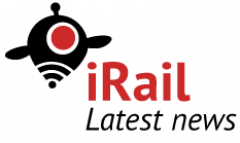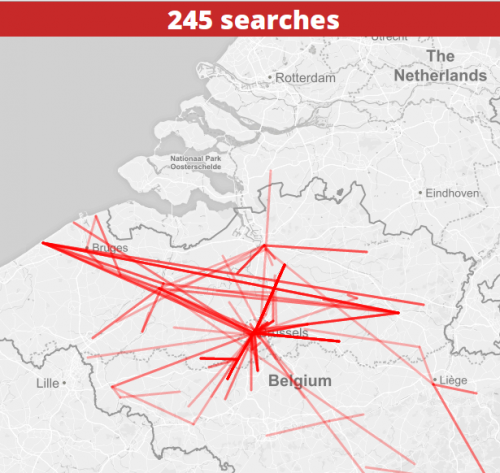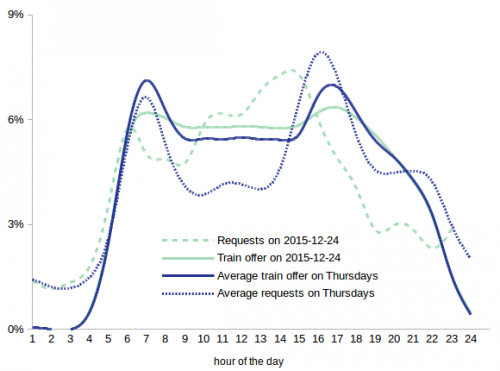Small enhancements of the API documentation
We have updated the API docs slightly over here:
https://hello.irail.be/api/1-0/
Change log:
- Vehicle information now contains much more data about arrivals, delays, cancelations, and so forth. It’s kept backward compatible, but the new properties should allow you to make richer application views
- https is now the default. http wil keep working though, again for backward compatibility
- More alternatives added for the stations list
If you have any feedback on the documentation please do let us know!
In our next update somewhere next week, we should also be able to show occupancy estimations of trains and POST feedback on this to our API. You can follow updates on that over here: https://github.com/iRail/iRail/pull/191. We are working on this with students of Spitsgids, thanks to https://spitsgids.be.
Visualizing our queries
On top of the iRail API, many requests happen. Even if we give concrete numbers, it remains difficult to understand how many requests we actually get. Serkan Yildiz, one of the open Summer of code students, created the open iRail map, that visualizes requests in real time. Check it out:
Always have a seat in the train
With our API’s query logs, with a ground truth by train specialists in Belgium, and with user feedback, we can show you how busy your train is. The only thing lacking to realizing this feature that the Dutch already have for years, is your support! Go to spitsgids.be and get a seat on your next journey.

Une app pour dire quand le train est trop plein ? Il fallait y penser. C’est le projet de @TreinTramBus et @iRail ! https://t.co/uqXda51osx
— Maxime Delrue (@mdelrue) April 18, 2016
We are launching https://t.co/oTBd1vhc52 (NL): let's crowd-fund how busy your @NMBS train is and make sure you always have a seat! #opendata
— iRail (@iRail) April 18, 2016
The start of a new era
Time flies! But we have great news:
It's official: @NMBS/@SNCB obliged to go #opendata by law. @openov #opentransport https://t.co/CS9bdoRaoM
— iRail (@iRail) April 13, 2016
We can now officially close the era where iRail has been an advocacy group for Open Transport Data, and instead become something we have always wanted to become: a Living Lab (and/or hackerspace) to work towards a better transport experience for travelers in Belgium. The next steps are going to entail a better collaboration with players like TreinTramBus, iMinds, the European Passenger Federation and everyone who has can help us reach our goal. A first thing is going to be announced next Monday, the 18th of April! We are quite psyched about this.
TreinTramBus and iRail have already been working together in the past, analyzing the query logs we have published in collaboration with iMinds’ Data Science Lab (my current employer). The research that has been carried out was presented at the WWW2016 conference in Canada, during the USEWOD workshop. The full paper can be downloaded here.
.@PieterColpaert @ #WWW2016, analysing query logs for train travel in Belgium in order to understand travel flows pic.twitter.com/Nh1uumEOcJ
— Marin Dimitrov (@marin_dim) April 11, 2016
January updates
We are only two weeks in 2016 and it seems like NMBS/SNCB is keeping its promise as a presentation announced they now have an internal innovation project on Open Data. But more inflables interestingly for us, the presentation, geving yesterday at the Digital Agenda Belgium event, announced they were wrong in 2010 sending Yeri a cease and desist letter. While people on twitter responded moderately (“How long is this going to take?”, “How about real-time data?”) we believe this is a huge step forward: it is the first time the NMBS/SNCB acknowledges we were on the right side of history. What iRail is concerned: we would love to start collaborating on a clean slate 🙂
We look forward collaborating with you @nmbs @sncb and start over with a clean slate 🙂 https://t.co/bD72fu6509
— iRail (@iRail) January 13, 2016
It doesn’t stop there, today, we are featured in De Standaard with a piece on how NMBS should make use of their data in a better way:
http://standaard.be/cnt/dmf20160112_02064462
Indeed: the query log files of iRail can be used as an indication of travel intention. You can now also reuse the log files yourself:
- Historic datadump from 2012 to 2016: https://github.com/pietercolpaert/irail-route-planning-query-logs
- Last 1000 requests refreshed each second: http://api.irail.be/logs/



